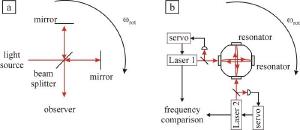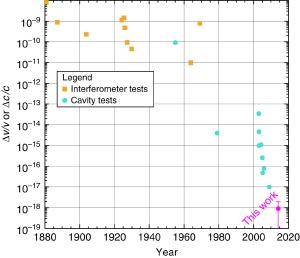Blog
Relativity Wins Again
15 September 2015
 Nagel, et al
Nagel, et alOne of the great things about science is how we keep testing our assumptions. Even when a phenomenon has been rigorously tested, we still push the limits of observation. Take, for example, some recent research on the speed of light.
According to relativity, the speed of light in a vacuum is an absolute constant. We’ve observed this fact for about a century, and by 1989 our measurements had gotten so precise that it’s been used to define the length of a meter ever since. As far as we can tell, the speed of light should be the same in all directions, and in all places in the universe. It’s a property often known as Lorentz symmetry or Lorentz covariance. If Lorentz symmetry is violated, then relativity is wrong. Some models trying to unify general relativity with quantum theory actually predict a violation of Lorentz symmetry by a tiny amount, so precise tests of it could provide clues to a truly unified physical model. But according to recent results presented in Nature Communications, relativity still holds true.1
The most popular method of demonstrating Lorentz symmetry follows the original work of Michelson and Morley, where a beam of light is split into two beams and reflected back so that the beams interfere with each other. This interferometry method is typically the method done by undergraduate physics students. But if you’re more interested in whether light speed varies with orientation, then a more accurate method uses cavity resonance. Laser beams are bounced within a chamber. This can create a resonance in the chamber.
 Nagel, et al
Nagel, et alIf you’ve ever swirled a wet finger around the rim of a wine glass, you know you can cause the glass to “ring” at a particular tone. Swirl your finger too quickly or slowly and it won’t work. There’s a “sweet point” where your finger moves just right, and the glass sings. A similar effect occurs with the resonator cavity. Light at just the right frequency will cause the cavity to resonate. If the speed of light is truly the same in all directions, then the frequency that works should be the same no matter what the orientation of the chamber. To eliminate any background vibrations, the team cooled their experiment to a mere 4 K.
In the end the team found no variation of the speed of light in different directions. Specifically, they confirmed Lorentz symmetry to about 9.2 × 10−19, which is an incredible precision. Once again, relativity passes the test.
Nagel, Moritz, et al. “Direct terrestrial test of Lorentz symmetry in electrodynamics to 10−18.” Nature Communications 6.1 (2015): 8174. ↩︎